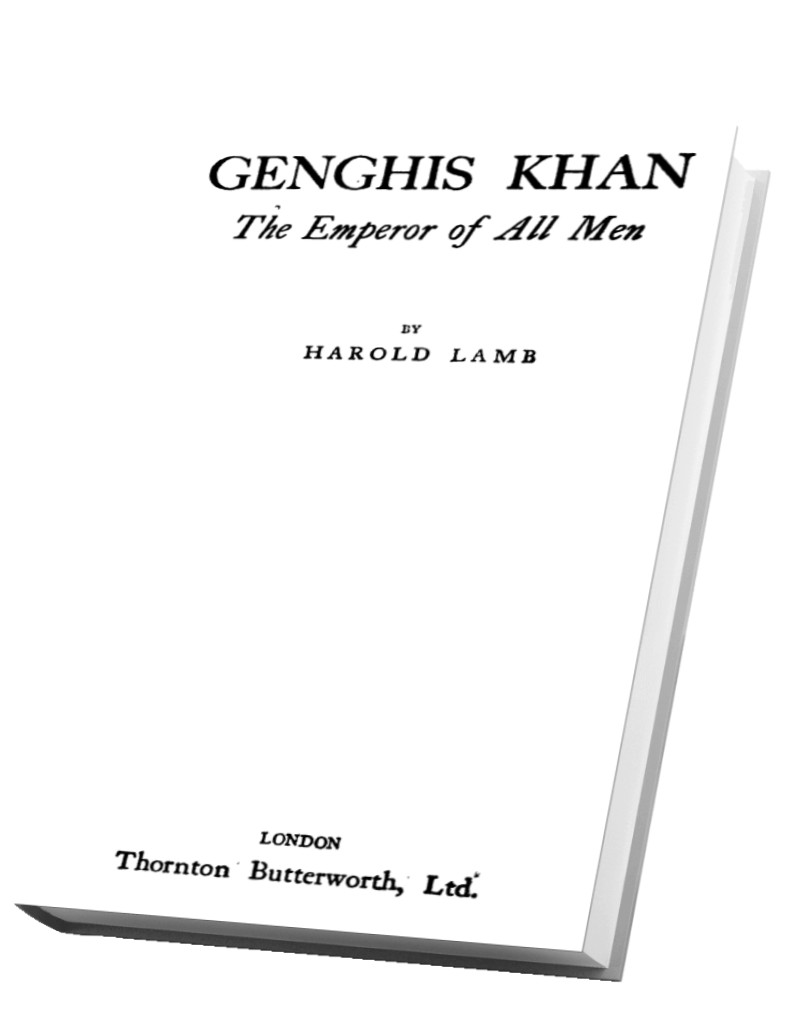Genghis Khan
The history of Genghis Khan comes from two main sources: (1) history books of countries he fought with and (2) a saga-like Mongolian book “Secret History of the Mongols” (an English translation of the book is provided below). The first source is obviously biased against him. The second source was written for the imperial family of the Mongol Empire soon after the death of Genghis Khan. It is a valuable source because it was written from a Mongolian perspective. But it probably downplays some of the cruelty of Genghis Khan. Thus, our understanding of the life of Genghis Khan may be far from accurate. It should also be noted that the year associated with the events of his life are only approximations.
Below is a 14th century CE portrait of him:

Genghis Khan is not only the creator of the largest contiguous land empire in history, he is also the ancestor of a large number of men -- about 16 millions, according to a 2003 DNA analysis. Less than a handful of known persons have so many descendants. A copy of the research paper is provided below.
In order to facilitate understanding of the conquests of Genghis Khan, a present-day map of the relevant areas is provided below:

Genghis Khan’s birth name was Temujin. Genghis Khan was an honorary title meaning “universal Ruler,” and was bestowed on him later in his life. His father, Yesugei, was the chief of the Borjigin clan. Temujin’s mother was named Hoelun and came from a noble background.
Below is a timeline for the first twenty years of his life (as explained above, the year of events are approximate):

The exact data and location of Temujin’s birth was uncertain. Most historians believe that he was born in 1162. A wide range of locations have been proposed as the location of his birth. The most likely location is a mountainous region in present-day northeast Mongolia.
Yesugei arranged a marriage for Temujin. When he was nine, Yesugei took him to the family of his future wife, Borte. Temujin was supposed to live with the family of Borte until age 12. Yesugei headed home after leaving Temujin with the family. During the journey he was poisoned by a band of Tatars and died. Upon receiving the news, Temujin returned home. By that time a rival clan family, Taychiut, took control of the clan. The Taychiut family and other clan members drove Hoelun and her children, including Temujin, off the clan.
For a time, the abandoned family led a life of extreme poverty. The financial pressure on the family was great and there were struggles among the male members of the family for power. In a dispute over the spoils of a hunting expedition, Temujin quarreled with and killed one of his half-brothers, who was older than Temujin. He now was the oldest male and became the head of the family.
When Temujin was about 14, he was captured and enslaved by another Mongol clan named Tayichiud. Temujin was able to persuade a guard who helped his daring escape. The escape earned him a good reputation.
The life of Temujin and his family improved during these years. When Temujin was 19, he went to see his father-in-law and claimed his wife, Borte. Temujin received a black sable cloak as dowry. Temujin and Borte returned home.
Soon after the marriage, Borte was kidnapped by a rival clan. Temujin appealed to his father’s anda (meaning “sworn brother” in Mongolian), a Mongol prince called Toghrul, for help. Toghrul promised to reunite Temujin with his clan and provided him with a small army. Toghril also persuaded a boyhood friend of Temujin, Jamuka, to supply an army as well. With their helps, Temujin was able to rescue Borte.
Borte was held captive for eight months, and gave birth to a son, Jochi, soon after she was rescued. This left doubt as to who the father of Jochi was because her captor could have possibly impregnated her. Despite this, Temujin let Jochi (1182-1227) remain in the family and claimed him as his own son. Borte had three more sons, Chagatai (1183–1242), Ogedei (1186–1241), and Tolui (1191–1232). Temujin had many other children with other wives, but they were excluded from the succession of his empire. Only Borte's sons could be considered to be his heirs.
The rescue of Borte helped Temujin to consolidate his power in his clan. There is not much information about Temujin between the year 1182 and 1191. He fought with the Tayichiud and Tatar many times with mixed results.
Temujin consolidated his power between 1191 and the time he was proclaimed the "Genghis Khan" in 1206 by fighting many major battles. Below are some of the battles. They illustrate the continuously shifting alliances among tribes.
1191: Temujin and Toghrul fought with the Merkit tribe. No major progress made by either side.
1193: Temujin and Jamukha joined forces to attack the Tayichiud. But then there were disputes between Temujin and Jamukha. The Tayichiud joined with Jamukha to fight against Temujin. No clear winner.
1195: Temujin and Toghrul helped the Jurchen Jin to defeat the Tatars.
1196-1198: Temujin and Toghrul defeated the Merkit tribe.
1200-1202: Temujin and Toghrul defeated the Naimans tribe.
1203: Toghrul joined forces with Jamukha to fight with Temujin. Temujin defeated them. Toghrul was killed by a member of another tribe while trying to escape. Jamukha escaped and sought the protection of the Merkits and Naimans.
1204: Temujin defeated the Merkits and Naimans. Temujin caught and killed Jamukha.
1206: Temujin then turned his attention to other tribes in and around Mongolia. By 1206, Temujin subdued and united the Merkits, Naimans, Mongols, Keraites, Tatars, and Uyghurs. In the summer of 1206 at a council of chiefs, Temujin was acknowledged as Khan of the consolidated tribes and took the new title "Genghis Khan," or the "Universal Ruler," at the Onon River. This resulted in peace between previously warring tribes, and a single political and military force was formed. The union became known as the Mongol empire.
Below is a 15th century illustration of the proclamation:
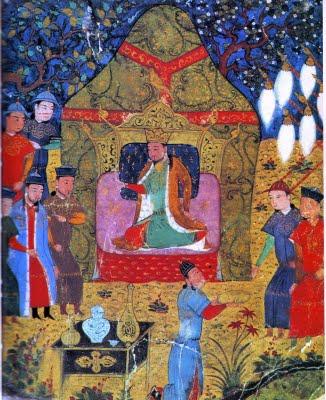
After consolidated power in Mongolia, Genghis Khan set his sight outside. Below is a timeline for major battles during the last twenty years of his life ("GK" stands for Genghis Khan). Again the year of events are approximate. Also, there were multiple battles in one year and the same country was attacked in multiple years.

In 1207 the Mongol Empire created by Genghis Khan and his allies shared its southwestern borders with the Great Xia dynasty of the Tanguts (also called Xi Xia, meaning western Xia, in Chinese texts). To the east and south was the Jurchen Jin dynasty, founded by the Manchurian, who ruled northern China as well as being the traditional overlords of the Mongolian tribes for centuries.
The initial states he invaded was the Great Xia. Genghis Khan started some initial raids along the border between Mongol and Great Xia. He then launched a full-scale invasion early 1209. By the end of the year and early 1210 the Emperor of Great Xia, Li Anquan, agreed to submit to Mongol rule and gave one of his daughters to Genghis Khan as a wife. Great Xia also joined force with the Mongol to attack Jurchen Jin.
Below is a map showing Great Xia (Xi Xia) and Jurchen Jin (Mongol was at the immediate north): The map also shows the Song dynasty, which are ruled by Han Chinese.

In 1211 Genghis Khan attacked Jin. At that time, Jin had driven the Chinese Song dynasty to the south and occupied northern China. Jin was able to field about 400,000 soldiers while Genghis Khan had about 100,000. But the high mobility of Genghis Khan’s force proved superior. To add to Jin's woes, they were beset with internal problems such as chronic corruption emptying the state coffers, natural disasters, and assassinations of top officials. Jin was compelled to retreat to the south, sign a peace deal and pay tribute to Genghis Khan in 1214. The peace deal was a short respite and worse was to come as the Mongol re-attacked the Jin in 1215. Genghis Khan captured and entered its capitol Zhongdu (the present-day Beijing) while Jin moved its capitol further south to Kaifeng city. Before completing the conquering of Jin, Genghis Khan turned his attention westward to attack another enemy. Eventually, the Jurchen Jin dynasty fell in 1234 under Genghis Khan’s third son and successor, Ogedei Khan.
Below is a 15th century drawing of Mongol soldiers:

While fighting Jin, Genghis Khan received an urgent request from a vassal state of the Mongol empire in 1216. The ruler of Qara Khitai (also spelled as Kara Khitai; it was called western Liao in Chinese texts) attacked the vassal. Qara Khitai was located in parts of present-day Xinjiang, Kazakhstan, Kyrgyzstan, Tajikistan, and Uzbekistan. Below is a map of present-day Central Asia so we can better identify the location of these countries:
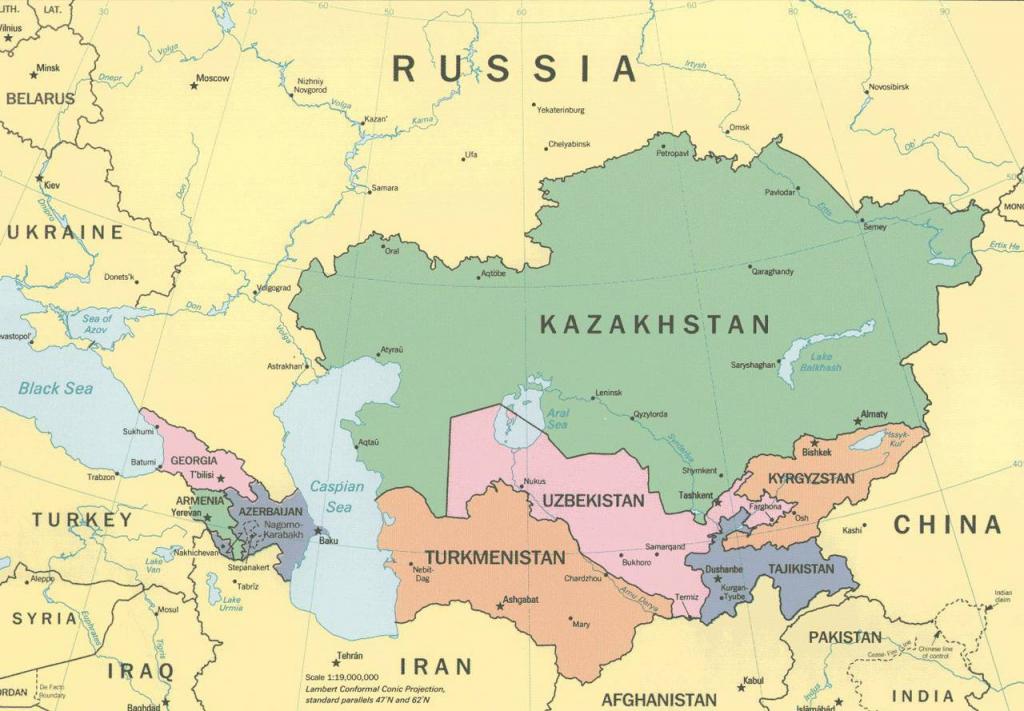
The ruler of the vassal, Ozar, was married to a daughter of Jochi, a son of Genghis Khan. Ozar was killed, and his supporters requested aid from Genghis Khan. Genghis Khan dispatched a general to fight with Qara Khitai, The general conquered it in 1217.
Below is a map of Qara Khitai showing its relative position to Great Xia (Xi Xia) and Mongolia:

While Genghis Khan was attacking Jin, a dispute with the Khwarazmian empire at the west changed his plan. The Khwarazmian empire was a big empire and ruled large parts of the present-day Central Asia, Afghanistan, and Iran. In 1218 there was a caravan of Mongol merchants passing through Khwarazmia. The governor of the Khwarazmian city of Otrar, Inalchuq, seized the caravan's goods and executed its members on charges of espionage. The Mongol demanded Inalchuq be punished. The Shah of the Khwarazmian empire rejected the demand, going so far as to kill one Mongol envoy and humiliate the other two. This was seen as a grave affront to Genghis Khan himself. He abandoned his war against the Jin, leaving only a small army to pursue it, and gathered as many men as possible to invade Khwarazmia.
Below is a map of Khwarazmia (Kara Khitai is shown at the northeast corner of the map). Names of locations in red are the present names of the locations.
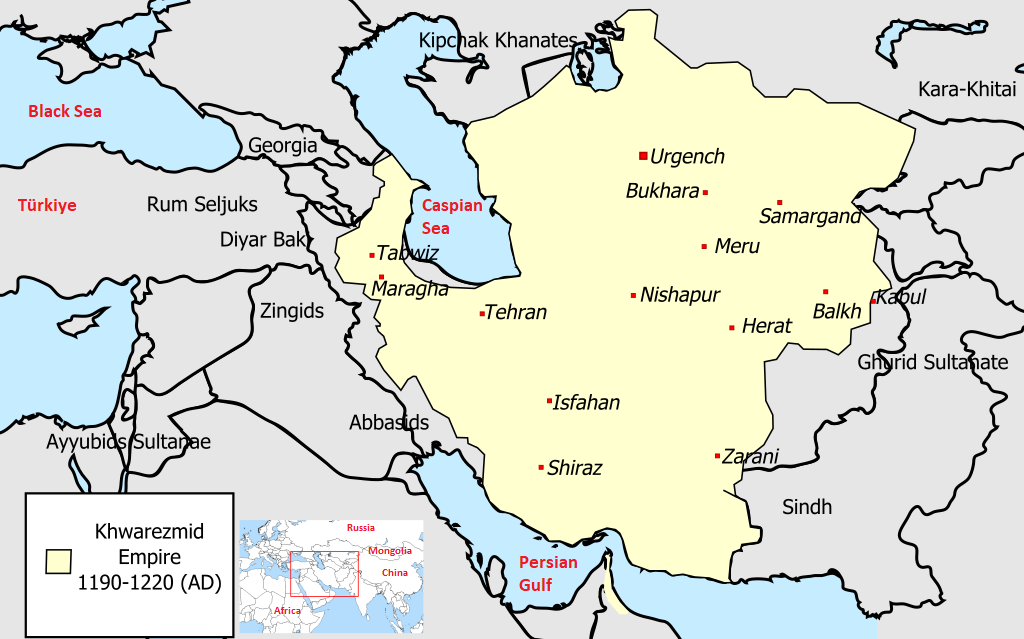
The Khwarazmian mounted an opposing force. There were fierce fights between the two armies. In some battles, the Mongols encountered big losses. But the Khwarazmian empire was eventually defeated in 1220. The Shah died and his son, Jalal-al Din, crossed the Indus river and went to India.
Below is a painting showing Jalal al-Din escaped the Mongol army by crossing the rapid Indus river:
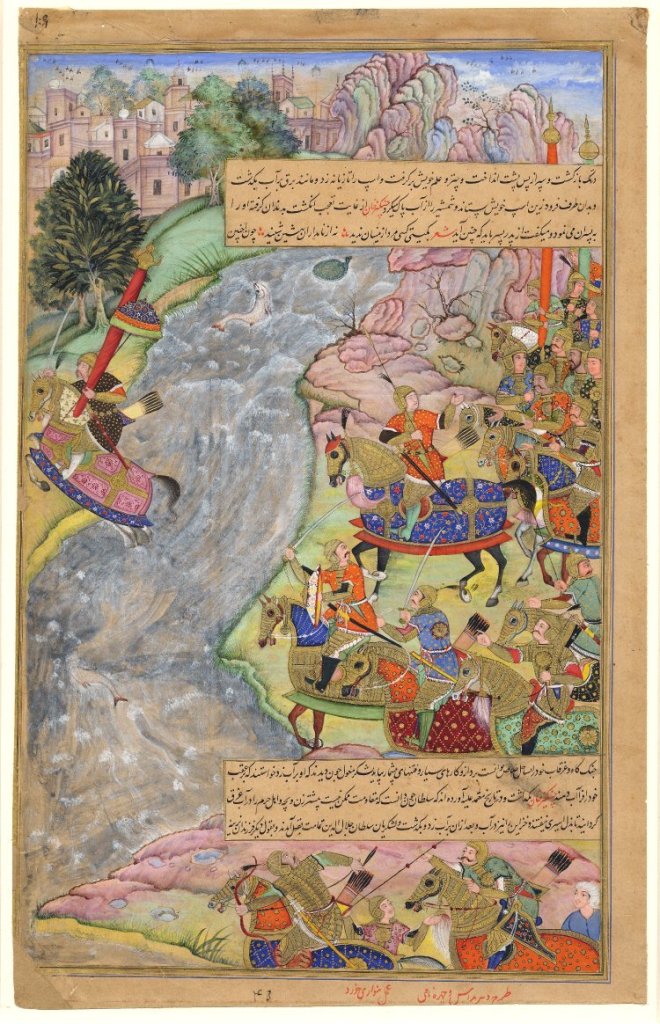
By this time, Genghis Khan wanted to return home. He split his army into two. He commanded the main army and returned to Mongolia through Afghanistan and northern India. The other army was commanded by two generals. They pushed into Armenia, Azerbaijan, Ukraine and part of eastern Europe and Russia.
After Genghis Khan left the Khwarazmian empire, there were rebellions in several cities. In response, Genghis Khan sent one of his sons back to the Khwarazmian empire to suppress the rebellions. In 1223, the Khwarazmian empire was destroyed and the Mongol were in control of all the territories.
In 1226, shortly after returning home from the west, Genghis Khan began a retaliatory attack on Great Xia, which had refused to take part in the Mongol war against the Khwarazmian empire. Genghis Khan died in August 1227 during a battle with Great Xia. The cause of his death was unknown. His body was returned to Mongolia and buried in an unknown location.
Below is a map showing the various stages of Genghis Khan's conquest:
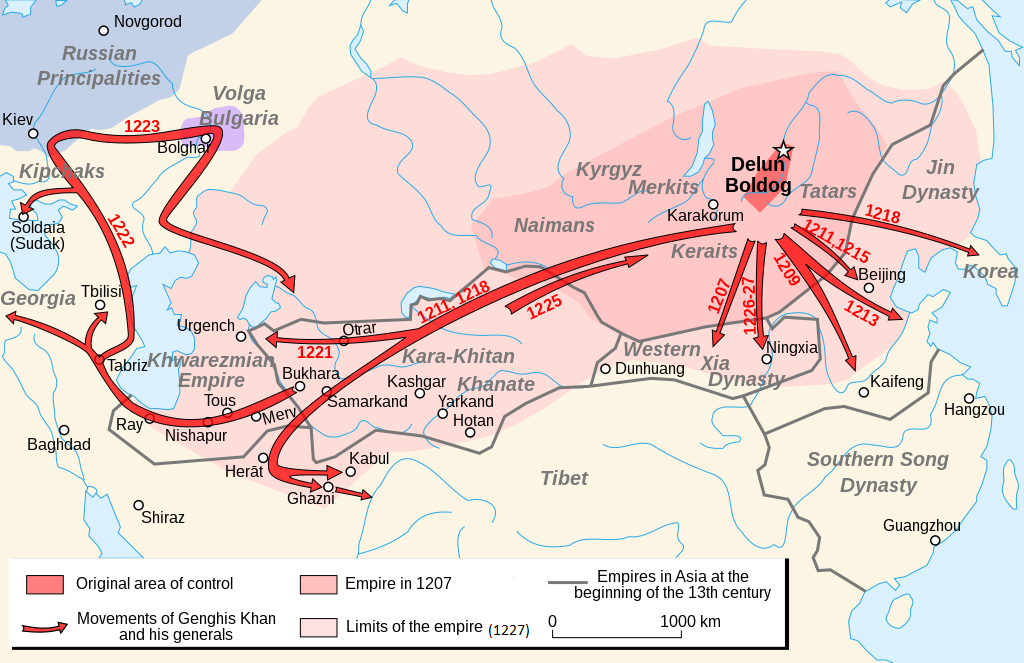
When Genghis Khan died, he conquered more than half of the territories of the Mongol empire. His sons and grandsons completed the work to create the largest contiguous land empire in history.
There is another legacy of Genghis Khan. A recent study found that he is the likely ancestor of 16 million men, which, according to the authors, comprise approximately 0.5% of the world population in 2003. You can read this 2003 research paper for details.
The Genetic Legacy of the Mongols
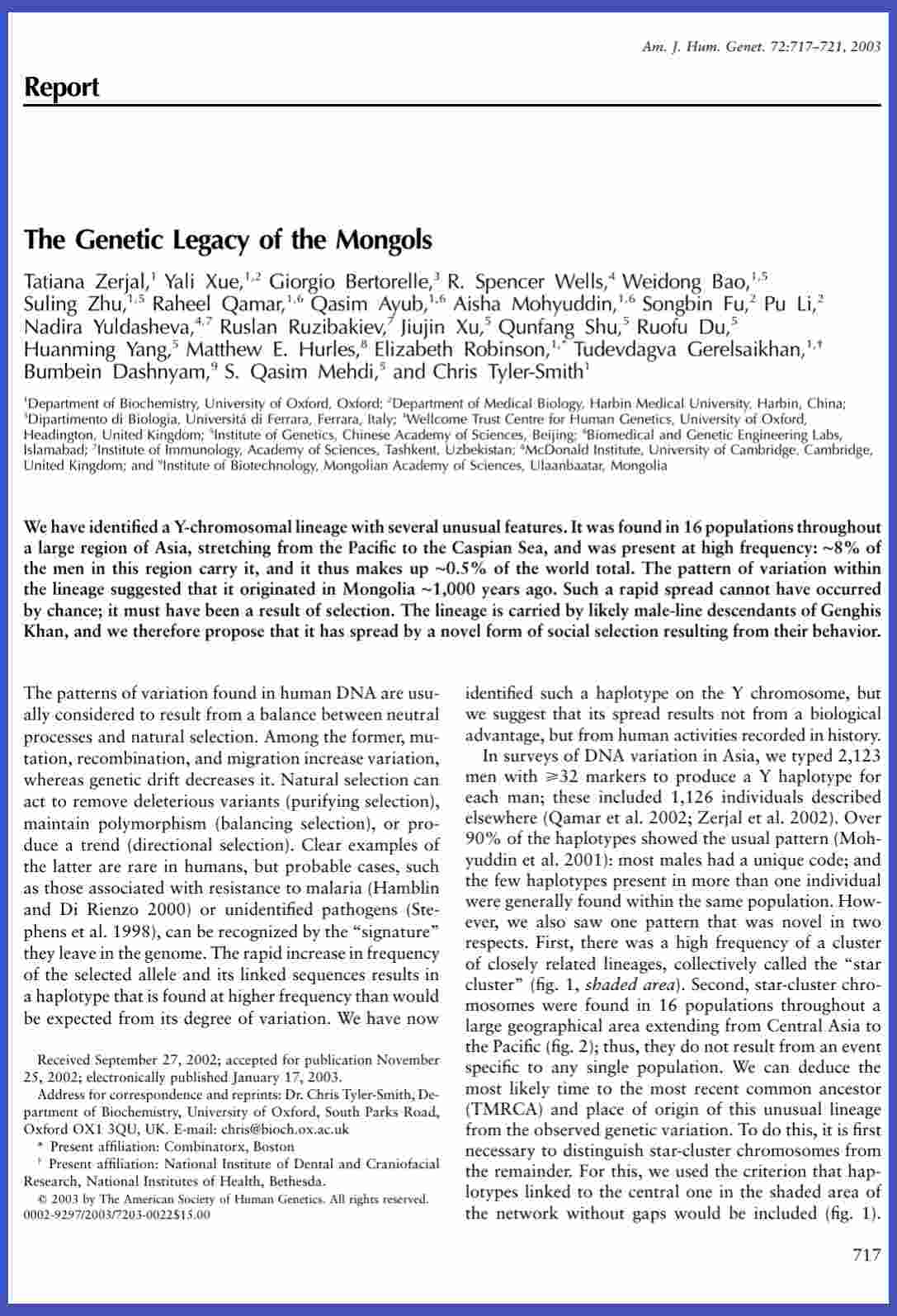
Two books of Genghis Khan are provided below:
(1) The Secret History of Mongols is the oldest surviving literary work in the Mongolian language. It was written for the Mongol royal family some time after the death of Genghis Khan. The author is anonymous and probably originally wrote in the Mongolian script, but the surviving texts all derive from transcriptions or translations into Chinese characters that date from the end of the 14th century. The Secret History is regarded as a piece of classic literature in both Mongolia and the rest of the world.
The Secret History of the Mongols
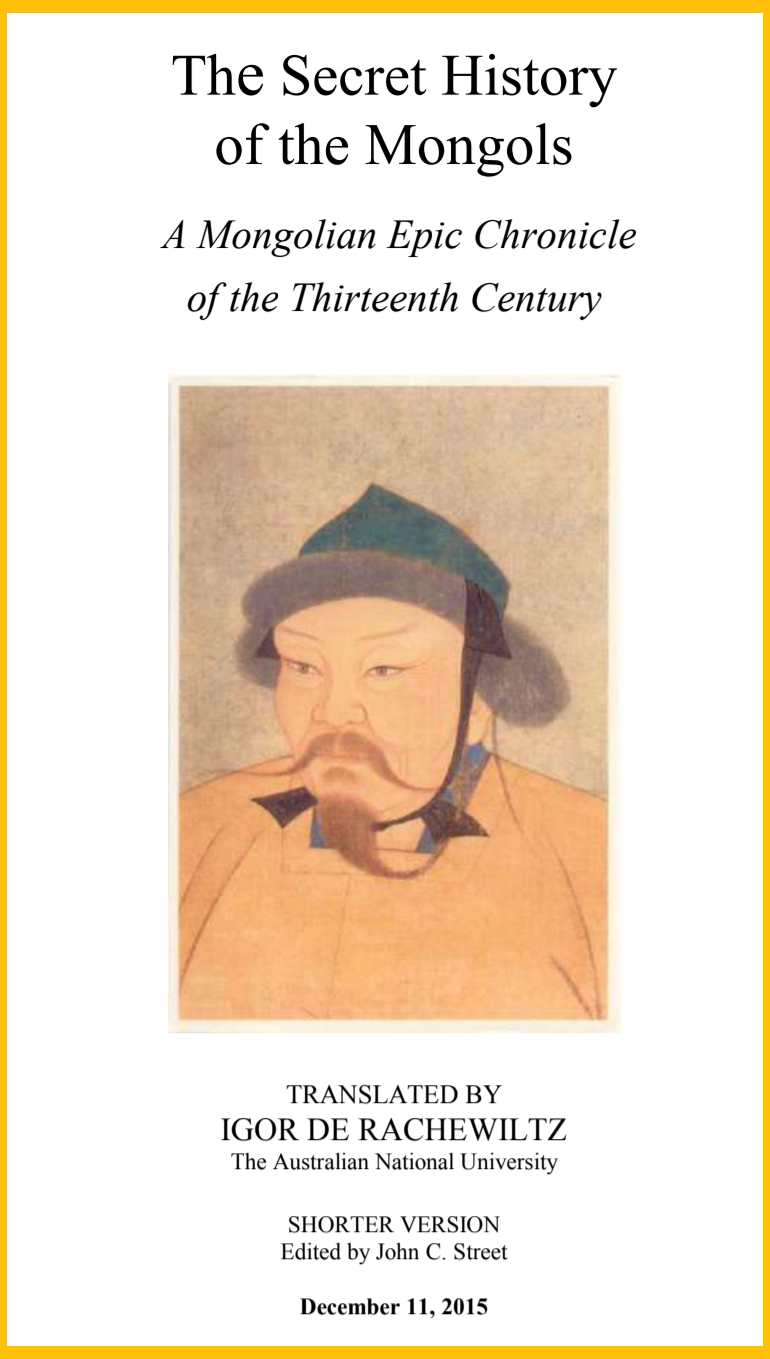
(2) A biography of Genghis Khan written by Harold Albert Lamb, an American historian, screenwriter, short story writer, and novelist
Genghis Khan - The Emperor of All Men (file size: about 13 MB)
